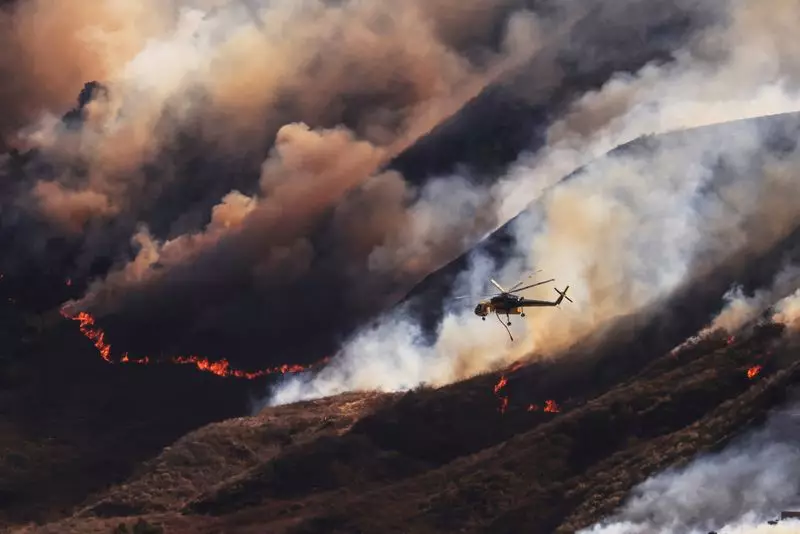As the sun rose over California, hearts were heavy with the weight of destruction wrought by the Mountain Fire, a relentless wildfire that has devastated numerous communities in Ventura County. Recent reports indicate that firefighters have begun to stabilize the situation with 2,400 brave souls battling the flames, which have ravaged at least 132 structures and left nearly 88 others damaged. Although over 10,000 residents were forced to evacuate, encouragingly, many have now begun the journey back home as containment efforts make progress.
The fire, which ignited on Wednesday, is located about 50 miles northwest of Los Angeles and has consumed a staggering 20,630 acres, remaining relatively unchanged in size for the 24 hours leading up to a press conference by Cal Fire officials. They reported an increase in containment from 7% to 14%, a small victory, yet a beacon of hope amidst the raging chaos. Calmer winds blowing from the Pacific Ocean have offered a much-needed reprieve from the previously gusty Santa Ana winds, which elevated the fire’s ferocity.
The emotional toll on the affected residents is palpable. Among them is Dennis Gottlieb, who, along with his wife Linda Fellerman, narrowly escaped the inferno. Standing in a shelter, he reflected on the nightmare of watching his life’s possessions disappear before his eyes. “Everything is gone. All gone. Burned up,” he lamented, emphasizing the surreal trauma that communities like his must navigate in the wake of such disasters.
Indeed, the human experience in the jaws of nature’s fury reveals the fragility of life as many residents are forced to confront the loss of not only their homes but also irreplaceable memories. Authorities estimate that while 3,500 homes are now safe for return, an additional 2,000 families remain under evacuation orders, looming uncertainty for many.
Amidst these catastrophic events lies a complex interplay of weather phenomena. The recent red flag warning for the area has been uplifted, signaling a shift in conditions, with humidity on the rise and winds expected to reach a maximum of merely 15 miles per hour, as opposed to earlier gusts that clocked in between 80 to 100 miles per hour. The respite should allow firefighters to strategize and potentially gain a more substantial foothold against the encroaching flames.
However, eyes remain firmly fixed on the horizon as meteorologists warn that while conditions might improve momentarily, winds are predicted to pick up again come Tuesday. This potential escalation adds an unsettling layer of tension, as firefighters continue their desperate fight against nature’s elements. “The rain chances are low to none,” noted Ariel Cohen, an NWS meteorologist, an ominous forecast for the scorched land.
The Mountain Fire is just one chapter in a year marked by an unnerving rate of wildfires across the United States. The National Interagency Fire Center reports that 8.1 million acres have been charred this year alone, a stark rise compared to the average annual burnt acreage of around 7 million for the previous decade. In California, this number is particularly alarming; fires have obliterated more than three times the amount of land that was lost by this same point last year.
Climate change is undeniably a contributing factor, with scientists warning that rising temperatures have transformed California’s landscape into a tinderbox. The lavish wet winters foster the growth of dry, flammable chaparral, while the blistering summer sun desiccates these landscapes, making them increasingly susceptible to wildfires.
Recovery and Road Ahead
The road to recovery is daunting, demanding resilience and fortitude from those impacted by the flames. For many, the emotional and psychological aftermath will linger long after the fires are extinguished. As Darren Kettle poignantly stated, “My heart dropped to my stomach. It’s just shocking, traumatic.” The challenge now lies not only in rebuilding homes and communities but in rekindling hope and healing amongst individuals and families affected by this catastrophic event.
As California grapples with the aftermath of the Mountain Fire, the resilience of its communities stands out. However, significant challenges remain ahead amidst the ever-solitary dance between destruction and recovery. As the unpredictability of climate continues to threaten safe havens, the collective resolve to rebuild must rise even stronger than the fires that have torn through these landscapes.

